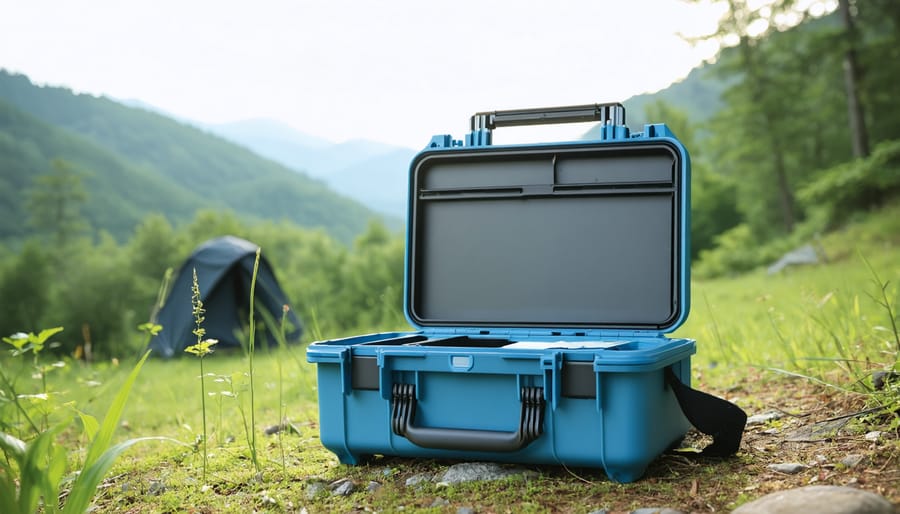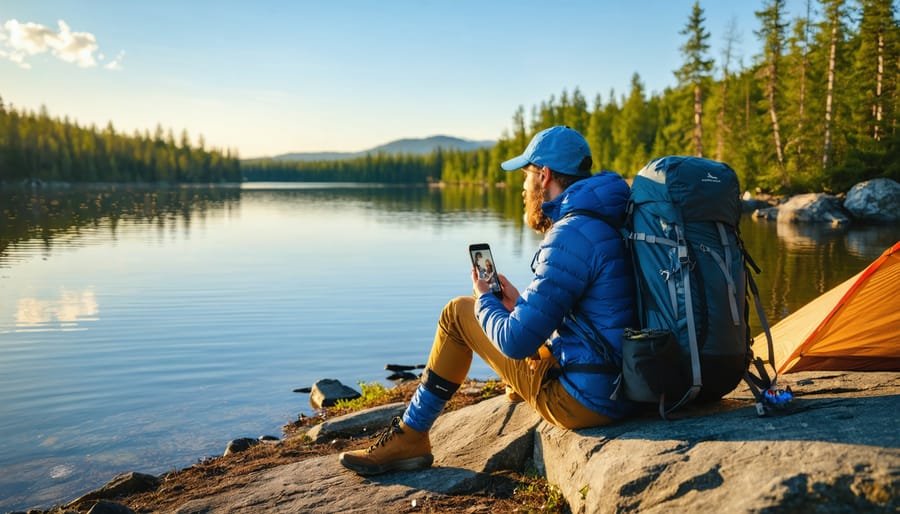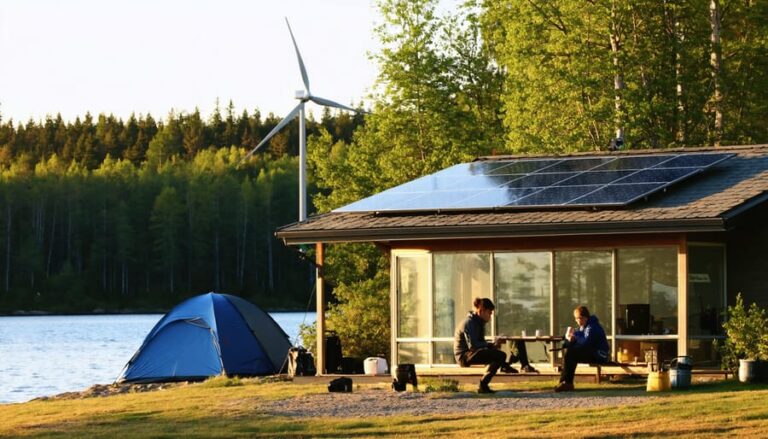Picture this: You’re three hours deep into Frontenac Provincial Park when your hiking partner twists an ankle badly enough to need medical advice. You pull out your phone, connect with a doctor through a video call, get professional guidance, and continue your trip safely. That virtual consultation you just had? It’s absolutely considered outpatient care—and understanding this classification matters more than you might think for your outdoor adventures.
Telehealth services fall squarely into the outpatient category because they don’t require hospital admission or overnight stays. Whether you’re video-chatting with your family doctor from a backcountry campsite or texting a nurse practitioner about that mysterious rash from your tent at Algonquin, you’re receiving outpatient care through digital means. This classification affects everything from insurance coverage to medical record-keeping, making it essential knowledge for Ontario’s outdoor enthusiasts.
The beauty of telehealth for remote campers lies in its accessibility—you can get professional medical attention without abandoning your wilderness experience or driving hours to the nearest clinic. For those of us who love exploring Ontario’s remote parks and trails, this means healthcare no longer ends where the pavement does. Understanding how telehealth works as outpatient care empowers you to make informed decisions about your health coverage, emergency preparedness, and medical documentation while embracing the great outdoors.
What Exactly Counts as Outpatient Care?
Let’s break down outpatient care in a way that makes sense, especially when you’re planning your next outdoor adventure in Ontario.
Think of outpatient care as any medical service where you walk in, get treated, and head home the same day—no overnight hospital stay required. It’s the “in-and-out” approach to healthcare. When you visit your family doctor for that hiking injury, pop into a walk-in clinic for bug bite concerns, or get X-rays after a rough canoe portage, you’re experiencing outpatient care.
The key difference? Inpatient care means you’re admitted to a hospital and stay overnight (or longer) for observation or treatment. Outpatient care means you’re treated and released within the same day, even if the appointment takes several hours.
Here’s a relatable example: Last summer, my friend twisted her ankle on the Bruce Trail. We drove to the nearest urgent care clinic, she got examined, received an X-ray, was fitted with a brace, and we were back at the trailhead (well, back at camp) by evening. That’s textbook outpatient care.
Outpatient services include everything from routine check-ups and minor procedures to physical therapy sessions, diagnostic tests, and yes—virtual consultations. The defining factor isn’t where you receive care or how you receive it; it’s whether you need to be formally admitted to a healthcare facility for overnight monitoring.
This distinction matters when you’re exploring Ontario’s wilderness areas. Knowing what qualifies as outpatient care helps you understand your healthcare coverage options, especially when you’re miles from the nearest emergency room and wondering if a virtual doctor visit counts.

The Short Answer: Telehealth IS Outpatient Care
Yes, telehealth is absolutely considered outpatient care! Here’s the straightforward answer: any healthcare service that doesn’t require an overnight hospital stay falls under the outpatient umbrella—and that includes your video consultation with a doctor, whether you’re calling from your living room couch or a tent at Algonquin Park.
From an insurance and billing perspective, telehealth services are classified exactly the same way as visiting a clinic in person. Your virtual appointment with a physician, nurse practitioner, or mental health professional is coded and billed as outpatient care. This matters because your insurance coverage, deductibles, and co-pays typically apply the same way they would for a traditional office visit.
**Here’s an insider tip**: Before heading into remote areas of Ontario, snap a photo of your insurance card and save your provider’s telehealth portal login info offline. I learned this the hard way when I needed a prescription refill at Bruce Peninsula National Park and scrambled to remember my login details with spotty cell service!
The beauty of telehealth being classified as outpatient care means you can access professional medical advice without abandoning your camping trip or cutting short your wilderness adventure. Whether you’re dealing with a minor injury, need medication management, or just want peace of mind about that mysterious rash, you’re receiving legitimate outpatient medical services—just with a more scenic backdrop than your typical doctor’s office.
How Telehealth Actually Works When You’re Off the Grid
Connectivity Realities in Ontario’s Parks
Let’s be real—if you’re counting on five bars of cell service at most Ontario parks, you’re in for a surprise. The connectivity situation varies dramatically depending on where you pitch your tent.
Parks closer to urban centers like Presqu’ile Provincial Park and Rock Point typically offer decent cell coverage, especially near visitor centers and main campgrounds. I’ve successfully connected to telehealth appointments from these locations without much trouble. Algonquin Park’s eastern access points (near Whitney) generally have workable signal, though it gets sketchy as you venture deeper into the backcountry.
Here’s the insider scoop: Killarney Provincial Park has notoriously spotty service—basically non-existent beyond the George Lake area. Similarly, most remote Ontario campgrounds offer minimal to zero connectivity, which is part of their charm but challenging for telehealth access.
Pro tips for better connectivity: campgrounds with electric hookups often have stronger signals since they’re closer to infrastructure. The camp office areas typically offer the best reception. Download offline maps and any medical documents before arriving, and consider investing in a signal booster if regular connectivity is essential.
Some parks now offer Wi-Fi hotspots near comfort stations—check park websites beforehand. Pinery Provincial Park and Sandbanks have relatively reliable service near facilities. Always have a backup plan: know where the nearest medical clinic is located, and inform your healthcare provider about potential connection issues when scheduling appointments.
Smart Tech Solutions for Remote Consultations
Getting connected in the backcountry doesn’t have to mean lugging heavy equipment or draining your battery in minutes. I’ve learned through trial and error—mostly during a memorable canoe trip where my phone died just before a scheduled virtual consultation—that smart preparation makes all the difference.
**Apps That Actually Work in Low-Signal Zones**
Start with offline-capable health apps before you head out. Apps like Doxy.me and Simple Practice offer compressed video that works surprisingly well on 2G connections. Download any appointment confirmations and medical forms while you’re still in civilization. My insider tip? Screenshot your health card and any prescription details—you’d be amazed how often you’ll need them when the internet decides to play hide-and-seek.
**Satellite Solutions Without Breaking the Bank**
Modern satellite communicators like the Garmin inReach Mini aren’t just for emergencies anymore. Many healthcare providers now accept text-based consultations, and these devices let you message your doctor from literally anywhere. At around $15 monthly for basic plans, it’s cheaper than most people think. Some Ontario parks are also rolling out smart park technology with dedicated Wi-Fi zones near ranger stations—check park websites before your trip.
**Eco-Friendly Tech Tips**
Solar chargers have come a long way. Look for foldable panels (20+ watts) that can power your devices without disposable batteries. The Goal Zero Nomad series has never let me down. Pro tip: Place your phone in airplane mode between scheduled consultations to extend battery life dramatically—you can still receive calls when you switch it back on for appointments.

Real Scenarios Where Outdoor Telehealth Saves the Day
Picture this: You’re three days into a backcountry camping trip in Algonquin Park when you notice an angry red rash spreading up your arm. That innocent-looking three-leaved plant you brushed against? Poison ivy. Before telehealth, you’d face a tough choice—pack up early and drive hours to the nearest clinic, or tough it out and hope it doesn’t worsen. Now, you can connect with a healthcare provider right from your campsite (assuming you’ve got cell service or can reach a spot that does), get a proper diagnosis, and receive a prescription sent to the pharmacy nearest your route home.
Or consider Sarah’s experience last summer while kayaking the French River. She realized she’d forgotten her blood pressure medication at home—a four-hour drive away. Instead of cutting her week-long adventure short, she used her phone to have a quick telehealth consultation. Within twenty minutes, her doctor reviewed her records, issued a refill, and sent it to a pharmacy in the nearby town of Monetville. Crisis averted, vacation saved.
Then there’s the classic twisted ankle scenario. Mark was hiking the Bruce Trail when he took an awkward step on loose rocks. His ankle swelled, but was it sprained or broken? A video consultation let the doctor assess his range of motion, observe the swelling, and provide guidance. Turned out it was a mild sprain—no emergency room visit needed. The doctor walked him through proper wrapping technique and advised continuing with caution.
These outpatient telehealth services shine brightest when you’re outdoors because they meet you where you are—literally. Whether it’s identifying bug bites, managing allergic reactions, or determining if that cut needs stitches, having medical expertise accessible from the wilderness transforms how we handle health hiccups during our adventures.
**Insider tip**: Download your telehealth app and test it before heading into remote areas. Save your pharmacy preferences and emergency contacts ahead of time for smoother consultations when connectivity is limited.

What Your Insurance Covers (And What It Doesn’t)
Here’s the good news: if you’re an Ontario resident with OHIP, telehealth services are typically covered just like regular outpatient visits—whether you’re video-chatting with your doctor from your backyard or a campsite with cell service. Since telehealth is classified as outpatient care, you won’t need special authorization for most virtual appointments.
But here’s where it gets tricky for visitors. If you’re traveling to Ontario from another province or country, your home health insurance might not automatically cover telehealth services accessed while you’re away. I learned this the hard way during a camping trip when a friend from Alberta needed a virtual consultation—her provincial coverage didn’t extend across borders as smoothly as we’d assumed.
**Before your outdoor adventure, verify these essentials:**
– Contact your insurance provider to confirm telehealth coverage outside your home province or country
– Ask specifically about virtual urgent care and walk-in clinic services
– Check if you need pre-authorization for telehealth appointments
– Understand whether prescription costs are included
– For international visitors, ensure your travel insurance explicitly covers telemedicine services
**Eco-friendly tip:** Keep digital copies of your insurance cards and policy numbers on your phone—no paper waste, and you’ll always have them accessible even in remote areas. Many insurance companies now offer apps that display your coverage details and even help you find covered telehealth providers nearby, which is incredibly handy when you’re exploring Ontario’s beautiful wilderness.
Planning Ahead: Your Outdoor Telehealth Checklist
Before you hit the trail or set up camp in Ontario’s beautiful backcountry, take thirty minutes to prepare your telehealth toolkit—it’ll save you hours of frustration if you need care.
**Download first, explore later.** Install your telehealth app and create your account while you still have reliable WiFi at home or in town. Test the video function to ensure everything works smoothly. I learned this the hard way when I couldn’t download a 200MB app update from my campsite with spotty reception!
**Know your coverage inside-out.** Screenshot your insurance card and save your policy details to your phone’s notes. Confirm whether your plan covers out-of-province telehealth visits if you’re traveling from outside Ontario. Write down your policy number—you’ll want it accessible even if your battery dies.
**Create an offline emergency file.** Save important phone numbers in your contacts: your family doctor, insurance provider, telehealth service, and a trusted emergency contact. Take photos of any prescriptions or medical documents you might need to reference.
**Pack smart companions.** Bring portable power solutions like solar chargers or battery banks to keep devices charged. Tuck a basic thermometer in your first-aid kit—telehealth providers often ask for your temperature. Consider a notebook for jotting down symptoms or instructions during calls when screen-sharing isn’t ideal.
These simple steps transform telehealth from a theoretical option into a practical safety net for your outdoor adventures.
Knowing that telehealth is considered outpatient care shouldn’t dampen your sense of adventure—it should actually amplify it! Think of it as having an invisible safety net that travels with you into Ontario’s beautiful backcountry. When you’re paddling across Algonquin’s pristine lakes or hiking the rugged trails of Killarney, you can embrace those experiences more fully knowing that medical guidance is just a phone call away.
This is what responsible outdoor recreation looks like in the 21st century. You’re not choosing between authentic wilderness immersion and modern healthcare access—you’re bringing both together. That poison ivy rash after your first portage? A quick telehealth consultation means you’re back to enjoying your trip rather than cutting it short. The peace of mind this provides is invaluable, especially for families with young children or anyone managing ongoing health conditions.
Here’s my insider tip: before your next Ontario park adventure, save your provincial telehealth number in your phone and confirm your coverage details. Pack that portable charger and download any necessary apps while you still have strong Wi-Fi. These simple preparations mean you’re ready for anything—twisted ankles, mysterious bug bites, or unexpected medication questions.
So go ahead, book that backcountry camping permit you’ve been eyeing. Explore those trails with confidence. Ontario’s wilderness is waiting, and now you know you’ve got the healthcare support you need, right in your pocket.














+ There are no comments
Add yours